Stop me if you’ve heard this one before.
A promising young startup or business hits a period of massive growth in the early years, only to find themselves completely stalling once they begin to mature. Like hitting a wall, businesses find themselves unable to capitalize on their early momentum and end up failing to grow any further.
So what’s stopping most companies from overcoming this hurdle?
The short answer is they don’t have an organic growth strategy.
Many entrepreneurs, especially those new in the game, make the mistake of getting distracted by the latest growth hacks and tactics on offer. These growth hacks can be a great way to give young businesses a much-needed boost, but the reality is that those kinds of quick wins don’t amount to a long-term organic growth strategy.
To achieve long-term sustainable growth—the kind of organic growth that turns a small business into a multi-million dollar business—you need to have the right strategy in place.
In this guide, I’ll walk you through exactly how to turn your business into an organic growth machine, including helping you define the right growth strategy for you and the six things every business can do to achieve long-term organic growth!
- What Is Organic Growth
- Why Organic Growth Is the Lifeblood for All Business
- The Top Three Drivers of Organic Growth
- How to Find Opportunities for Organic Growth
- 6 Easy Tactics to Stimulate Organic Growth
What Is Organic Growth?
Organic growth is when an organization expands its operations and captures a larger market share by using internal resources. This type of growth is generally achieved through a mixture of factors, such as more streamlined systems and procedures, continuous optimization of core business areas, and the development of new products or services.
Why Organic Growth Is the Lifeblood for All Businesses
Simply put, not all business growth is the same.
Even though an organization can use hundreds, if not thousands, of different tactics to grow and extend its reach, organic growth is the ideal scenario for every business out there. After all, there’s not much point in expanding your business if you can’t do it sustainably and profitably.
While inorganic growth—also known as external growth—can provide organizations with an immediate boost and allow them to scale much faster in the short-term, it can actually cost the business more in the long-run. The main reason for this is that inorganic growth tactics often require a lot of upfront investment and capital, which can lead to being saddled with paying off huge debts later and a lower return on investment overall.
In fact, research from McKinsey has revealed that businesses that grow organically consistently outperformed their competitors in the long-run, in terms of revenue growth and shareholder value.
Organic growth strategies give businesses the ability to grow without having to rely on external resources, such as securing funding from outside investors or merging with another company. By continually reinvesting in themselves and looking for organic growth opportunities, business owners can scale naturally and at their own pace without having to expose themselves to potentially risky scenarios, like losing control over their own business or becoming a victim of growing too fast.
We often tend to forget that growing a business is a marathon and not a race.
In the search for growth hacks and quick results, it can be easy to lose sight of the bigger picture and only focus on what’s in front of you.
“Scaling is actually a problem of less. There are lots of things that used to work that don’t work anymore, so you have to get rid of them. There are probably a bunch of things you’ve always done that slowed you down without you realizing it.”
—Robert Sutton, organizational behavior expert at Stanford’s School of Engineering.
When executed well, an organic growth strategy not only signals to others your commitment to building a successful business, but it also gives you the ability to scale without having to compromise on your vision.
In developing an organic growth machine, you’re not just looking for quick ways to attract more leads or nab a few more sales. Instead, you’re focusing on creating long-lasting, sustainable, and profitable business growth.

The Top Three Drivers of Organic Growth
Generating organic growth is impossible unless you have the right pieces in place.
Many startup founders and entrepreneurs make the common mistake of focusing on the wrong things when pushing for growth. Tactics like investing in new technology, focusing on loyal customers, and becoming more aggressive with sales are all important in driving growth, but often, founders forget to build the foundation needed to support these tactics.
It’s a lot like trying to build a car without first making sure you have an engine.
Before you start developing your organic growth strategy, make sure that you have the right infrastructure in place for sustainable growth.
When it comes to scaling and expanding your business, here are the top three things your business needs to drive organic growth.
Hire and Nurture Top Talent
Your business’s ability to grow relies entirely on your team’s capacity to execute.
The reality of the situation is that it doesn’t matter how innovative or well-crafted your organic growth strategy may be, unless you have the right people to implement your vision.
Which is exactly why, according to multiple surveys by CMO Survey, having the right talent has consistently been a top factor in driving organic growth.
The most obvious place to start in making sure you have top talent on your side is to only hire A-players.
“If you’re able to land intelligent, self-directed humans, the results can be magical. There’s a “rich get richer” flywheel mechanism when it comes to hiring—high-caliber folks do great work, leading to better business outcomes, creating a more engaging work environment, which helps you bring on more awesome people.”
That doesn’t necessarily mean you should only hire the people who look the best on paper or have the most technical knowledge. Instead, you should be looking for people who possess that critical combination of characteristics, such as grit, curiosity, and teamwork, that give them the ability to perform at a high level regardless of the setting.
These are the people who you can trust to be smarter than you and give you the freedom to work on your business and not just in it.
Besides hiring top talent, it’s also important to continuously nurture your team. One recent Oxford Economics report found that high-growth companies were 16% more likely to have a formal mentoring program than their underperforming counterparts.
The more you can help your team members grow as individuals, the faster your business will grow.
Of course, to bring out the best in your employees, you need to develop the type of organizational culture that’ll allow them to thrive, which brings us to…
Culture of Innovation
The next important factor in building an organic growth machine is to ensure that your business has the type of culture that allows for innovative ideas.
A critical part of achieving long-term growth is to keep in mind that growth is a constantly moving target. Your business does not exist in a vacuum, and as it grows, you will inevitably have to face different problems that will require different solutions. For this reason alone, your organization’s ability to be flexible and adapt to each new challenge is critical to its capacity to grow organically.
An innovative culture is much harder to achieve the further along you are in your business, so you must start baking innovation into your business’s DNA as soon as possible.
In fact, in McKinsey’s latest global survey on growth, the vast majority of top-growth companies agreed that developing the right organizational culture and mindset was the most important factor in achieving organic growth, no matter what the strategy.
To establish a culture of innovation, you must first make sure that everyone is speaking the same language when it comes to growth. As the leader, it’s your job to articulate clearly the company’s values, what innovation exactly means, and define what “good growth” is.
“Teams figure out what they want to do themselves, and we give them feedback as to whether they’re being too ambitious or too conservative,”
—Aditya Agarwal, VP of Engineering at Dropbox and former Director of Product Engineering at Facebook.
Make it clear to everyone that small failures and setbacks are a natural part of innovation and to accept the fact that chasing after growth can get messy. In encouraging your team to take risks and explore new ideas, your business will inevitably grow and come out stronger, no matter what kind of challenge it has to face.
Strong Systems and Procedures
The final piece of the puzzle in unlocking organic growth is setting up strong systems and procedures that will allow for continuous growth, even when you’re not around.
Strong systems and procedures are the backbones of every successful organic growth machine. Without them, all you’re doing is lurching from one growth tactic to the other, with no clear understanding of what’s working, why something is working, and how it’s working.
Failure to implement an effective system for growth early on is often the main reason why so many would-be successful startups fail to continue scaling beyond a certain point.
“Unfortunately as you hire more people, the casual, informal “do what it takes” culture, which worked so well at less than 40 people becomes chaotic and less effective.”
—Steve Blank, Serial Entrepreneur, Author, And Educator.
A strong framework for organic growth not only drastically reduces the amount of cognitive load you have, but it also clearly communicates which methods, tactics, and strategies your team should be pursuing to grow.
Instead of leaving it to your team to figure things out on their own, team members can hit the ground running if they already know exactly what they need to do, or have a resource they can refer to anytime they have an issue.
For example, a key step of any organic growth strategy is regularly conducting research to make sure your business is moving in the right direction.
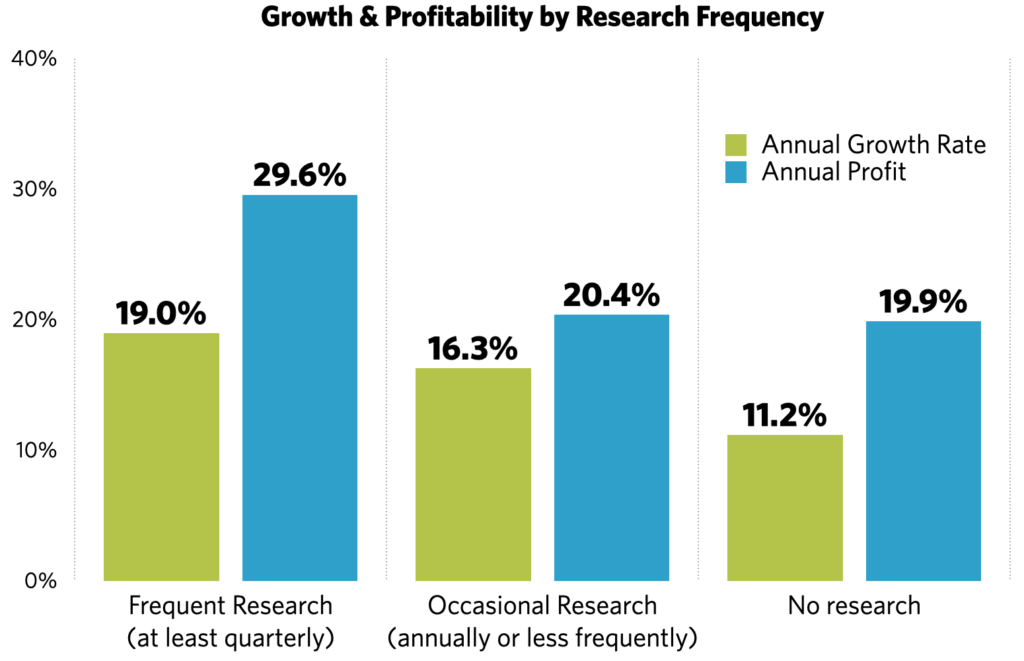
By outlining the steps a team member needs to take to conduct that research, you maximize this particular task’s efficiency while maintaining the consistency and quality of the result.
Keep in mind that your initial set of systems and procedures doesn’t have to be perfect from the get-go because you can iterate and optimize them as you go. As much as we love the idea of scaling rapidly, organic growth is an iterative process rather than one that happens in leaps and bounds.
“Growth is about implementing a rigorous, customer insight and data-driven process with a sustained effort to remove friction.”
—Brian Rothenberg, Partner at defy.vc and ex-VP of Growth at Eventbrite.
Pro tip: Get into the habit of creating checklists, SOPs, manuals, and other resources as soon as possible; it’ll be a lot harder to do later on.
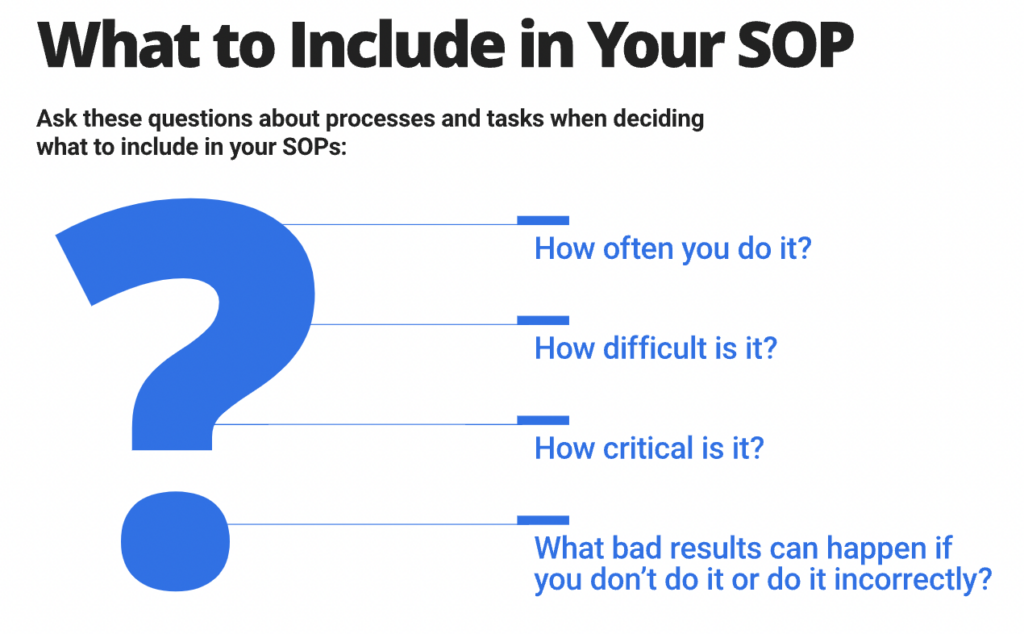
How to Find Opportunities for Organic Growth
There is no one-size-fits-all strategy when it comes to generating organic growth.
When it comes to developing your organic growth strategy, it’s critical to recognize that what works for someone else might not work for you. Even big players like Coca-Cola and Microsoft can get it wrong sometimes and end up investing millions of dollars into a strategy that ultimately doesn’t work for them.
So, where does that leave you?
Well, as you’ll see later on in examples, there are a variety of methods and tactics you can apply to achieve your strategic growth goals. The key is to learn how to recognize and understand the best organic growth opportunities for you.
What Can You Be Doing Better?
The first, and by far the easiest, place to start when it comes to identifying organic growth opportunities is simply asking yourself: What can I be doing better right now?
It’s easy to fall into the trap of believing that the only way to achieve business growth is to constantly develop new products or expand your service offerings. While that’s certainly one aspect of growth (something we’ll get into a little later), often the most effective way to achieve organic growth is to look for opportunities to improve and optimize your current business.
This strategy might not be flashy or exciting to read about, but the small incremental changes you make in your business are usually the ones that lead to long-term organic growth.
Improving something by a measly 5%, or even 2%, might not seem much, but make those small improvements throughout your entire business and it will all add up over time.
“As you start to scale, much of growth is about gaining compound interest: a lot of small-to-medium improvements that compound and, over time, drive substantial growth. This might look like running a series of experiments that improve conversion by incrementally smaller percentages, for example.”
—Brian Rothenberg, Partner at defy.vc and ex-VP of Growth at Eventbrite.
There is always room for improvement; it’s up to you to recognize what you can be doing better.
For example, say the majority of your prospects end up spending too much time in a specific phase of your sales cycle. Streamlining that part of your sales process can lead to a faster overall sales velocity, leading to more conversions and sales in less time.

Pro tip: Don’t get caught in the optimization trap where you’re so focused on the details that you lose sight of the big picture. Know your numbers so you know which tweaks and improvements will lead to an actual difference in your business.
Determine Your Organic Growth Approach
The next step to identifying organic growth opportunities is to start working out your overall organic growth approach.
Broadly speaking, though, as defined by McKinsey, the three main approaches to generating organic growth are: investing, creating, and performing.
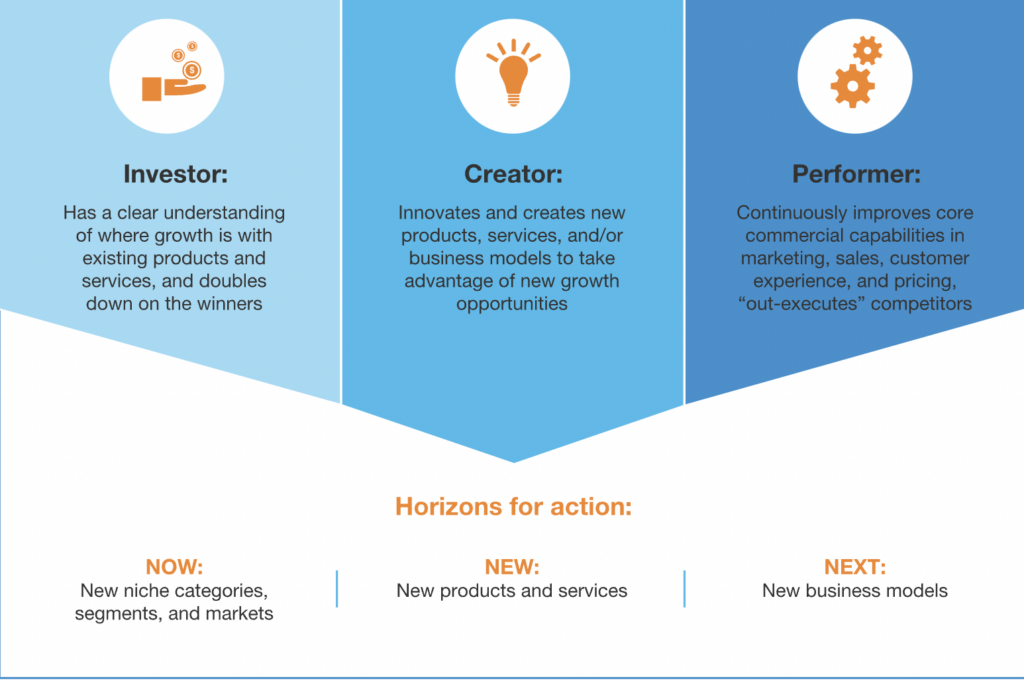
Investing
For many top-growth companies (44% of them to be exact), investing is the primary strategy for organic growth.
To put it simply, investing is when an organization is able to identify and double-down on the best-performing areas of their business.
For example, advertising through LinkedIn might be especially successful for you, so an easy way to acquire more customers is to simply increase the budget for your LinkedIn Ads.
While this all looks quite easy on the surface, don’t be fooled. To make this approach work for you, you’ll need to do more than just throw money at something and hope it pays off.
The only way for this approach to be effective is for you to have a clear understanding of what the high-growth areas of your business are. You need to confidently articulate how and why this piece of your business is doing so well and what investing more money into it will do; otherwise, you’re just throwing money into the wind.
Creating
Perhaps the riskiest approach to organic growth, as well as being the highest potential for reward, is creating.
Instead of improving what already works, you’re specifically looking for opportunities to deliver on customer needs that you’re not currently addressing. This might involve building new products, addressing new customer segments, or even developing entirely new business models.
As any experienced entrepreneur or VC will tell you: no matter how well-optimized your business is, it is inevitable that you’ll hit a point of diminishing returns. At some point, you’ll have to do something new, which is why it comes as no surprise that over 50% of organizations say they’ll focus on creating in the future.

In practice, the key to making the creating approach work for you is making sure that your business has a culture of innovation and that you have a process in place for rapid experimentation.
Creating something new is always risky, so you need to run quick, inexpensive tests to simultaneously make informed decisions and figure out if something is working before investing any significant resources.
Performing
As we touched on earlier, one of the most effective ways to achieve organic growth is by continuously optimizing and improving your existing business.
Specifically, you’re looking for areas in your business where you can eliminate inefficiencies, increase the speed of core processes, and introduce automation.
“Companies that pursue the Performer approach to growth are literally able to generate a 5, 10, or 15 percent increase in their revenue production with the exact same investment in their sales and marketing engine.”
—Liz Hilton Segel, senior partner and leader of the Marketing & Sales Practice in the Americas at McKinsey.
Your best friend when it comes to optimizing your business is, and always will be, data.
However, not all data is the same. It’s vital that you know and understand your key metrics from your big-picture metrics, like Customer Acquisition Cost (CAC), to the more granular and detailed metrics, like the number of recurring visitors on your website.
It’s only when you have a firm grasp of your numbers that you’ll be able to identify which areas of your business you can start improving.
Pro tip: Don’t be afraid to diversify your approach to your organic growth strategy. According to McKinsey, the most successful companies embrace two or more approaches to organic growth, maximizing their chances of discovering high-growth opportunities.

Always Look Ahead
Finally, every solid organic growth strategy should explore disruptive ideas, even if it means completely changing your business model and creating something entirely from scratch.
In Guy Kawasaki’s fantastic TED talk on the “Art of Innovation,” he tells the story of the ice harvesting industry.
In the olden days, the entire ice industry was built around people going to frozen lakes and ponds and cutting out chunks of ice, which would then be shipped to consumers. The problem was that these ice harvesting businesses would only focus on improving what already worked, which meant getting faster horses and more sleighs.
Thirty years later, a major technological breakthrough came and ice factories became a thing, eliminating the need for ice harvesting and disrupting the industry altogether. Another thirty years later, and another technological breakthrough gave every household its own freezer, allowing people to make ice without having to rely on the ice factories.
This is a classic tale and one you can see playing out with modern-day companies like Netflix, AirBnB, and FedEx disrupting entire industries that have existed for decades.
The moral of this story is that companies should look beyond defining themselves around what they do, and instead focus on defining themselves by the value they provide.
The goal isn’t to get better at harvesting ice; the goal is to make ice easily accessible to every household.
To build a long-lasting organization, you need to look ahead and experiment with new ideas, explore different ways of doing things, and test unconventional theories. Even if it means going against the best practices of the time.

Chances are that the vast majority of these initiatives won’t pan out, and that’s okay. The few that do work for you will have a huge impact on your entire business.
BONUS: How to Invest in Business Growth
Right off the bat, you have Harvard Business Review’s Innovation Ambition Matrix, a framework designed to help businesses understand how much they should invest in their various growth initiatives.
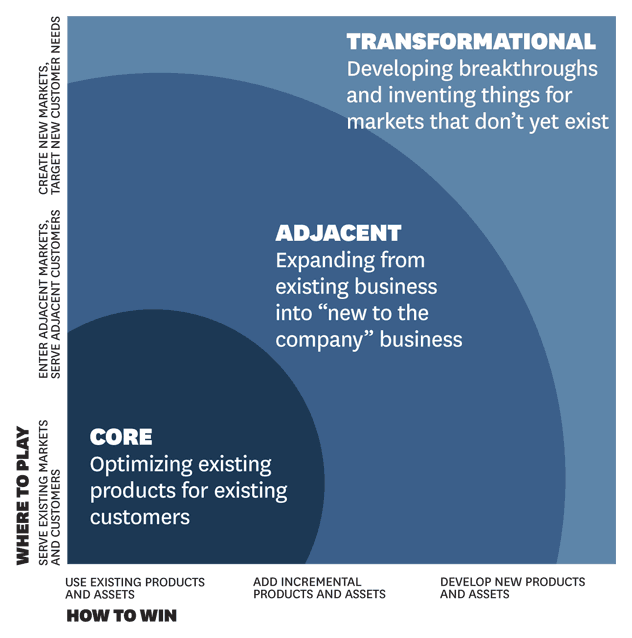
At the bottom left of the graphic are the core initiatives, which primarily revolve around optimizing and improving your current product and customers. At the other end of the spectrum are the transformational initiatives, the real blue-ocean kind of stuff that focuses on entering new markets or producing entirely new products. In the middle are the adjacent initiatives, strategies, and tactics that aim to expand your current business model and bridge the gap between your core initiatives and transformational initiatives.
While there are no hard and fast rules on how much you should be investing in each area, you generally want to adhere to the 70/20/10 rule.

70% of your growth strategy should focus on core initiatives, 20% should focus on testing and running experiments with your adjacent initiatives, and 10% should be devoted to researching and experimenting with something entirely new.
6 Easy Tactics to Stimulate Organic Growth
Now that you have a solid understanding of what your organic growth strategy looks like, the next step is to find the right combination of tactics to drive your strategy. In other words, it’s time to figure out the tools you need to build your organic growth engine.
To help you out with this, I’ve put together a list of six easy tactics that have been proven to work and can be used by any business, no matter how large or small. Even better, I’ll show you exactly how you can implement these tactics in your business.
Without further ado, let’s dive into the things you can be doing to drive long-term, sustainable organic growth!
Tactic #1—Leverage Evergreen Content
I’m sure you’ve heard this before, but it’s worth repeating again.
If you’re not already leveraging evergreen content, then you need to put in a plan for it by tomorrow.=
In the digital age we live in, evergreen content is essential to building an authoritative and influential brand. It’s the linchpin of every successful modern marketing strategy with 81% of B2C and 91% of B2B marketers actively investing in evergreen content, whether it be videos, quizzes, or good ol’ fashioned blogging.
Evergreen content never gets old. It’s so valuable that people bookmark it so they can revisit it over and over again (remember to bookmark this article!).
Besides the short-term benefits content marketing can have on your SEO, conversions, and sales, evergreen content also has the power to generate an amazing long-term ROI.
Evergreen, in-depth content will consistently drive high-quality visitors, backlinks, and leads to your site years after you’ve published it. But the beneficial and valuable nature of evergreen content also means that it’s also a great way to build a sense of trust, authority, and influence around your brand.
According to DemandMetric, brands that utilize evergreen content generate 67% more conversions. Another recent report by HubSpot found that high-quality blog posts can have a “compounding” effect on your organic search traffic, generating as much as 340% more traffic in two years.

Just take a look at how Elizabeth McCravy generated over $65,000 in revenue in one year using one personality quiz.
Looking to create a more fun and interactive lead magnet to set herself apart from the thousands of free e-books and guides out there, Elizabeth created a website personality quiz to engage with her audience and help them figure out the perfect look for their website.
The quiz proved to be the perfect lead magnet and—after embedding it on her homepage—it quickly generated Elizabeth tens of thousands in sales within the first few months. Even more impressive, the very same quiz is continuing to generate her tens of thousands in sales to this very day!
Tactic #2—Identify and Segment Your Best Customers
To unlock organic growth, identify who your best customers are.
By understanding what your ideal customer looks like—from their demographic to psychographic information—you’ll gain important insights into how you can better focus your marketing efforts, acquire higher-quality leads, and reduce unnecessary costs.
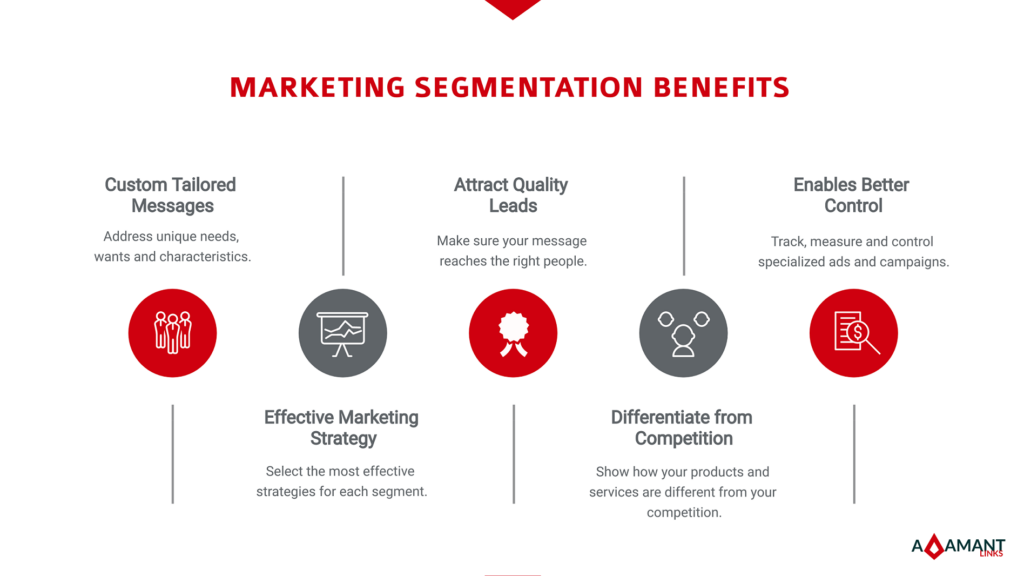
Unless you happen to have an extremely specific product within an extremely specific industry, chances are that you’ll have more than one type of customer, each with their own motivations and goals when it comes to doing business with you.
Instead of marketing to everyone the same way and pleasing no one as a result, by having a market segmentation strategy in place, you can tailor your content and offers to the specific interests of each segment. No one likes feeling as if they’re just another face in the crowd. The modern customer now expects a certain level of personalization when communicating with a brand.
According to a survey by Epsilon, more than 80% of consumers reported that they’re more likely to do business with a brand that uses personalization in their marketing. Another survey by eConsultancy found 80% of companies seeing increased revenue due to personalization, with businesses using advanced personalization techniques reporting a whopping $20 return for every $1 spent.
The great news is that you don’t need to invest hundreds of thousands of dollars into building a sophisticated market segmentation process when all you need is a well-designed personality quiz.
Melissa Konecky of Direct To Success discovered that she had three main customer types and that she needed to discern what segment each new lead fell into to nurture them accordingly.
And so, she developed a personality quiz specifically designed to help leads segment themselves into one of her three customer personas.
After taking the quiz, the lead will receive an email sequence that’s been tailored to their specific customer persona, ultimately directing them to Melissa’s flagship products, one of which is an online course priced at $3,500.
This tactic proved to be incredibly successful and allowed Melissa to automatically segment, nurture, and convert thousands of new leads without any additional effort.
Tactic #3—Invest in Co-Marketing Opportunities
When we talk about organic growth, we often limit ourselves with the idea that we have to do everything on our own, without any help from others. Nothing could be further from the truth.
A common challenge for many businesses is finding a way to get their brand in front of their target audience.
However, what if I told you there’s a way to generate high-quality leads and sales for your business by helping other brands with their marketing?
This might sound a little counterintuitive, but I guarantee you that co-marketing is a tactic worth exploring if you haven’t already.
Social media management platform Sprout Social’s co-marketing program drove 25,000 new leads in 18 months; they also discovered that leads generated through their co-marketing efforts were far likelier to convert and spend more money than leads acquired through any other channel.
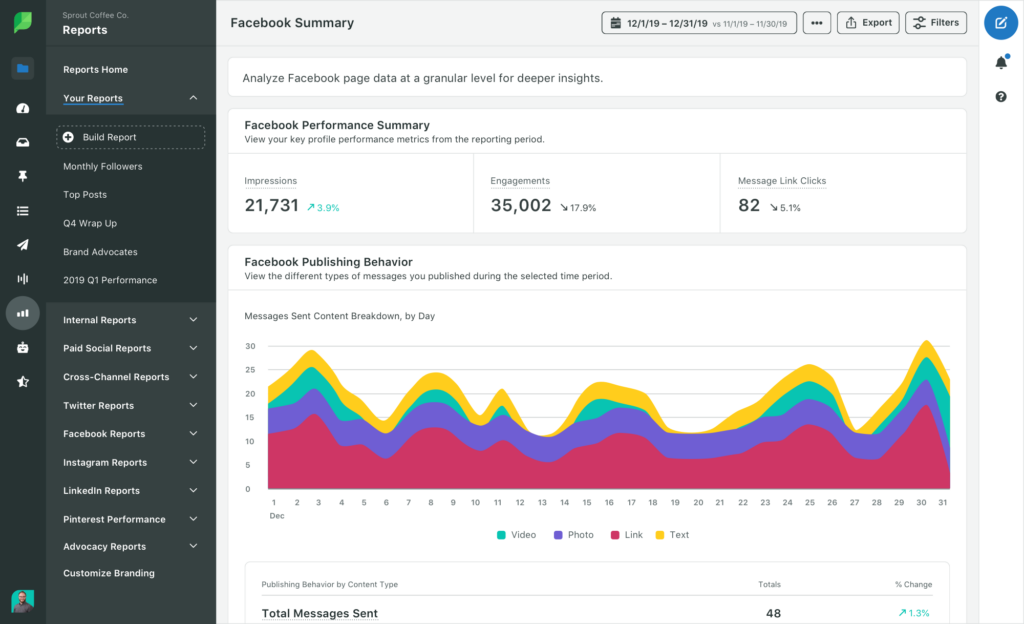
A great example of a successful co-marketing partnership is the one between KlientBoost and Invoca, which helped KlientBoost grow their agency from zero to $1 million in annual revenue in just 12 months!
After discovering that Invoca shared the same target audience of small-to-medium sized business owners, KlientBoost reached out to them and offered to create an e-book with them for free. In return for creating the e-book, KlientBoost asked Invoca to promote it to their audience and automatically share with KlientBoost the contact details of anyone that downloaded the lead magnet.
Invoca leapt at the opportunity. Together they ended up developing a 94-page guide on retargeting campaigns that not only addressed a major pain point for their audience but also introduced them to KlientBoost’s brand.
Instead of trying to build an audience from scratch, KlientBoost was able to cut through all the noise and reach their target customer directly through co-marketing, leveraging Invoca’s existing reach and audience.
Co-marketing allowed KlientBoost to piggyback off of the sense of “know, like, and trust” that Invoca already had with their audience. They created a tailored marketing campaign that immediately established themselves as a trustworthy expert in the eyes of these new prospects.
Tactic #4—Constantly Run Agile Experiments
We’ve already touched on the importance of innovation when it comes to organic growth, but how do we separate the good ideas from the bad ones?
No matter how great you think your idea may be, it’s critical that you test it out before investing significant resources into it. Many companies have made the mistake of investing millions of dollars into what they think is a sure-fire idea only to have it backfire completely.
When you take a look at the most successful and innovative organizations in the world, what becomes clear is that they all have a system in place to help them acquire, process, and move on information quickly and effectively.
One such system of innovation is the Pretotyping process.
Developed by Alberto Savoia, innovation agitator emeritus at Google and innovation lecturer at Stanford, the pretotyping process is designed to help organizations validate new ideas as quickly and as accurately as possible.
The basic premise is that organizations that rapidly test their assumptions with small-scale experiments will have access to more accurate information and make better decisions as a result. By taking this approach, companies will be able to act swiftly on potential successes and avoid wasting time with “slow failures,” experiments that ultimately end up nowhere and only serve to eat up valuable time and resources.

What sets pretotyping apart from similar concepts—like prototyping or MVP (minimum viable process)—is that pretotyping reduces a potential product or feature idea to its most basic components. You’re not trying to build a working version of your product, you just want to see if the idea will even appeal to the market.
Case in point, when Ben Tejes was looking to develop a new feature for Ascend, he needed to work out what feature he should invest his limited resources into. After all, he couldn’t just create something and hope that it would work.
He created a simple quiz to help him understand his audience’s major points. The quiz itself had only a handful of questions, but it provided Ben with the information and validation he needed to direct his efforts.
With this small-scale experiment, Ben saw what people were responding to—and then he developed his next product feature.
Tactic #5 —Develop an Automated Sales Funnel
Let’s face it, growing a business is a lot of work.
There’s constantly something new to worry about, something that requires your full attention. Being a business owner means juggling the dozens, if not hundreds, of daily tasks required to keep a successful business running—let alone growing.
One easy solution to this is to develop an automated sales funnel.
Managing cashflow is one of the biggest problems for any growing business, and having a reliable source of income can be a godsend. An automated sales funnel is designed to do just that, to help you reduce the amount of busywork involved with generating a sale and give you back the time you need to focus on the more important elements of your business.
According to the Annuitas Group, companies that used marketing automation to nurture prospects saw, on average, a 451% increase in qualified leads. This is further backed up by another study by InvespCRO, which found companies who excelled at lead nurturing generated 50% more sales-ready leads at a 33% lower cost.
With the right automated sales funnel in place, you don’t have to worry about whether or not leads and prospects are being segmented properly or if they’re receiving the right content at the right time. Even better, with an automated sales funnel, you know that it’s constantly working in the background, bringing in leads and generating sales for your business.
At Interact, we’ve seen a lot of our e-commerce users develop crazy successful sales funnels with a quiz.
One of my personal favorite examples is how BeanBox uses their coffee quiz to help direct new customers to the right product.
In this short seven-question quiz, potential customers are asked questions about how they prepare their coffee and the types of flavors they enjoy the most.
After completing the quiz, quiz-takers see a personalized results page featuring a short list of products they can immediately purchase and a strong call-to-action for a $5 starter kit.
It’s a very simple offer, but one that’s proven to be extremely effective, driving a huge amount of sign-ups and conversions for BeanBox.
But the sales funnel doesn’t end there.
BeanBox understands that not everyone is ready to buy right then and there, which is why they use a targeted Facebook ad campaign to follow up with prospects.
By setting up a Facebook Ad that specifically retargets people who have taken the quiz, BeanBox is able to simultaneously capture any lost customers, encourage people to re-engage with their sales funnel, and lower their overall ad spend.
Tactic #6—Keep Your Customers Happy
Customer experience is the new battleground for business.
In a world where markets are becoming increasingly crowded, it’s getting harder and harder for businesses to differentiate themselves. Providing an experience that leaves a smile on a customer’s face is by far the best way to rise to the top.
In a study by Hubspot, they surveyed over 1,600 C-suite executives and customer service representatives worldwide, finding that growing companies were 21% more likely to prioritize customer success over companies with stagnant or declining revenue.
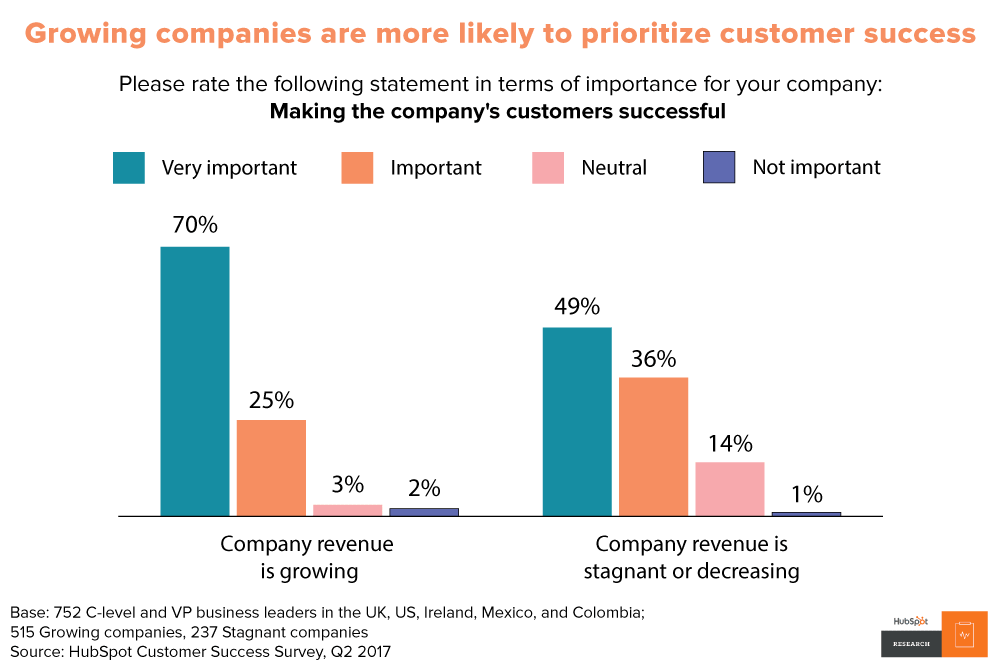
The study also reported that the most successful companies prioritized customer success across all departments. These businesses understand that the happier a customer is, the more likely they are to spend money, make repeat purchases, and provide positive referrals to your business.
Plus, with high-quality customer experience, you can charge more. According to a report by American Express, the average consumer is willing to pay 16% more for a product or service if they can be assured of receiving a positive experience.
One problem companies have is that they assume what customers want, instead of actually listening to their customers in the first place.
It’s so important to have a customer feedback loop in place, so you can keep your ear to the ground and finger on the pulse of what your audience is feeling.
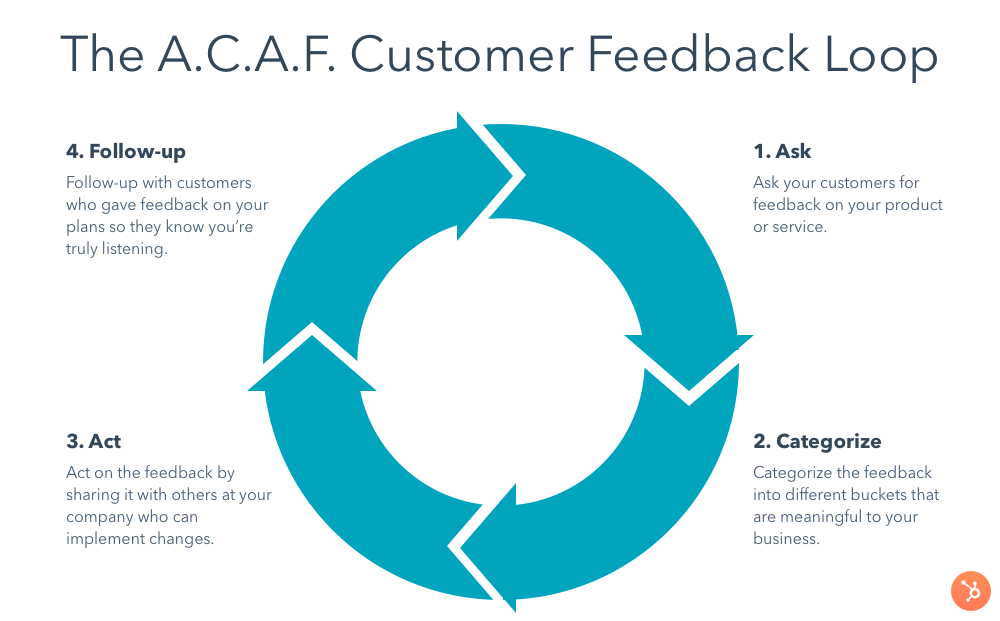
Easily set up a customer feedback loop by using Interact to build your customer survey form. By integrating that quiz with your email client or on your website, you’ll immediately have an easy way to collect and process your customer success efforts at scale.
There are a wide variety of questions you can ask on your customer survey, but in the interests of keeping things simple, I’d recommend starting off with your standard NPS (Net Promoter Score) question, asking people how likely they are to recommend your brand to a friend.
Within Interact, you can set up specific messages that trigger depending on how the person answers.
For example, if a customer says that they’re “not satisfied,” you can trigger an email to apologize for the negative experience and ask if they’d be willing to share any further details.
Get ahead of the curve and keep your customers happy with a simple quiz.